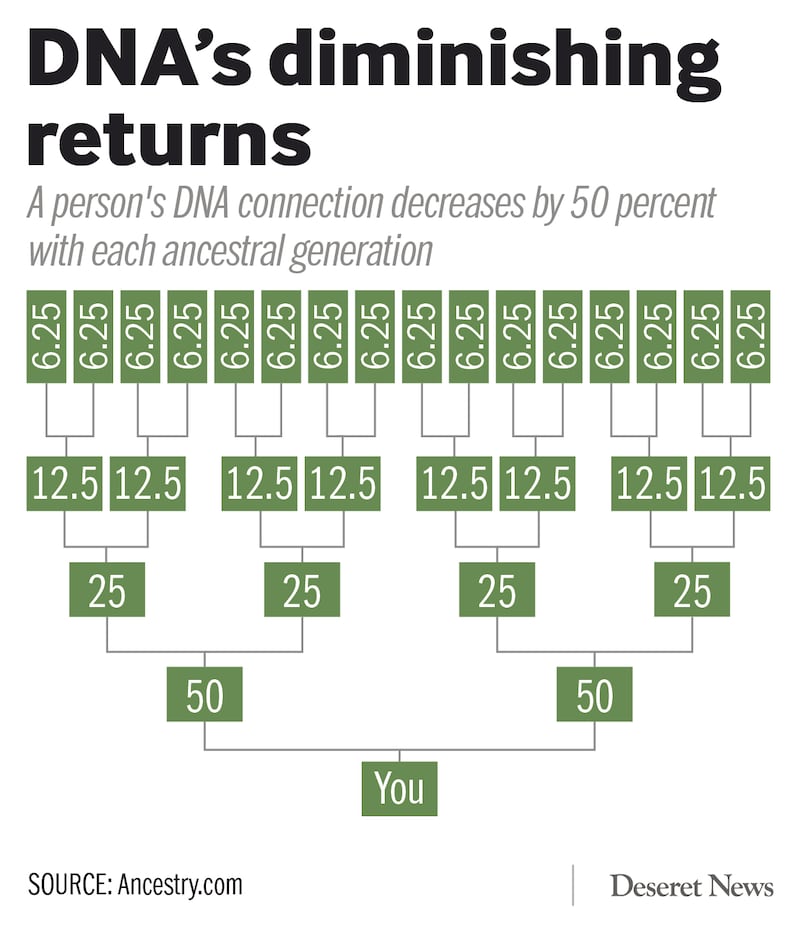LEHI — Twitter, Facebook and other social media nodes erupted a few months ago following DNA analysis tweaks made by Ancestry.com that changed, in some cases dramatically, the ethnicity profiles the company has provided to millions of clients.
While some customers celebrated changes as coming closer to what they know about their heritage through other means, like historical records, many online commentors were incensed about the updated results.
Earlier this month, Twitter user Alexis Wore posted results from her Ancestry.com update that showed an initial ethnicity profile that assessed her as being 52 percent of Senegalese decent, 26 percent Nigerian and less than 1 percent Mali. After Ancestry.com's analysis changes, those numbers changed to 48 percent Mali, 14 percent Senegalese and about 3 percent Nigerian. Her response was representative of many customer comments about changes to their own reports.
"How can my results change so much," Wore wrote. "Were the first that inaccurate?"

Ancestry.com's director of scientific communications Dr. Barry Starr explained that the changes customer's are seeing are the result of two signficant changes the company made to how it analyzes DNA it extracts from submitted saliva samples.
Starr said Ancestry.com greatly expanded its DNA test reference panel, a set of genetic samples that have clear connections, genetically speaking, to specific geographic regions. Whereas the company was using a reference panel of about 3,500 samples, it expanded that set to about 18,000 samples. Also, Starr noted the company now looks for matches in strings of DNA, as opposed to its previous technique of identifying single marker matches. Both changes are upgrades, according to Starr, which reflect ongoing advances in the bigger field of genetic research.
"This really is cutting-edge science," Starr said. "What we're looking at is hundreds of thousands of genomes across their entire DNA. With our previous method, we looked at those markers in isolation. With the new approach, we're looking at whole segments, or chains, which better approximates what happens when DNA is passed on."
Starr said the upgrades to Ancestry.com's assessment procedures has allowed the company to differentiate some new geographic locations more specifically than the old technique. For example, while some genetic markers were noted simply as evidence of a customer's "Scandinavian" heritage, the company is now stipulating Swedish and Norwegian origins.
Starr said Ancestry.com's enormous trove of DNA samples, currently representing over 10 million individuals, has aided the company in improving its approach and expanding its reference panel.
"One of the great advantages of Ancestry is a lot of our customers have family tree research which means we can validate, from a document standpoint, origin information," Starr said. "By improving our reference panel, we get a better understanding of what markers are common and which can differ in population."
University of Utah professor of human genetics Aaron Quinlan said when it comes to tracking ethnicity via DNA, it's important to distinguish between a person's genealogical records and genetic evidence.
"Our sense of genealogy is a narrative which can be supported with historical and family records," Quinlan said. "And, while many people think we can track DNA back many generations, we really can't draw useful information past about seven generations."
Quinlan explained that any individual's genetic makeup represents about half a contribution from each parent. One tier up the family tree, and each of those parents is getting half of their genes from a parent, and so forth. Trying to assemble a picture of our ethnic histories, based on that tracking, gets hazy very quickly.
"The way I like to think about it is like a patchwork quilt," Quinlan said. "The further we reach back, the smaller the patches of genetic information remains. Companies like Ancestry and others are trying to compare one patchwork to other patchworks."
Quinlan, who teaches genetics and studies rare genetic disorders, said the changes Ancestry has implemented in searching for string matches instead of individual marker matches tracks with the changes in genetic research. He noted the technique "is more informative as these are typically inherited in groups."
Utah State University student and part-time genealogist Julie Thurgood-Johnson said she noted the changes in her own ethnicity profile when Ancestry.com instituted its analysis upgrades and noted the revisions more closely matched other records she's tracked down about her family history.
"The estimates for my own background are definitely closer based on my research," Thurgood-Johnson said. "But, you really have to take the DNA analysis with a grain of salt."
Thurgood-Johnson has been researching her own family background and assisting others with genealogy searches for over a decade. She said the key to uncovering meaningful family histories was really about combining "old-fashioned" research techniques like tracking down documents and speaking with family members with the additional information that can be gleaned from DNA test results, like the kind Ancestry.com offers.
"Finding a good paper trail is a great way to start," Thurgood-Johnson said. "That, and finding relatives like distant cousins that can offer further information and insight, help you build the bigger picture, the bigger story about who you are."
Thurgood-Johnson noted, from a personal perspective, the additional details provided by Ancestry.com after the company upgraded its ethnicity profile results only made her more appreciative of her background.
"It's definitely extended my family," Thurgood-Johnson said. "I had a deep appreciation for all cultures before, but now to be able to say, 'I'm even more Irish, I'm even more African and I'm even more Native American,' is wonderful and Ancestry has been able to help me piece that all together."


